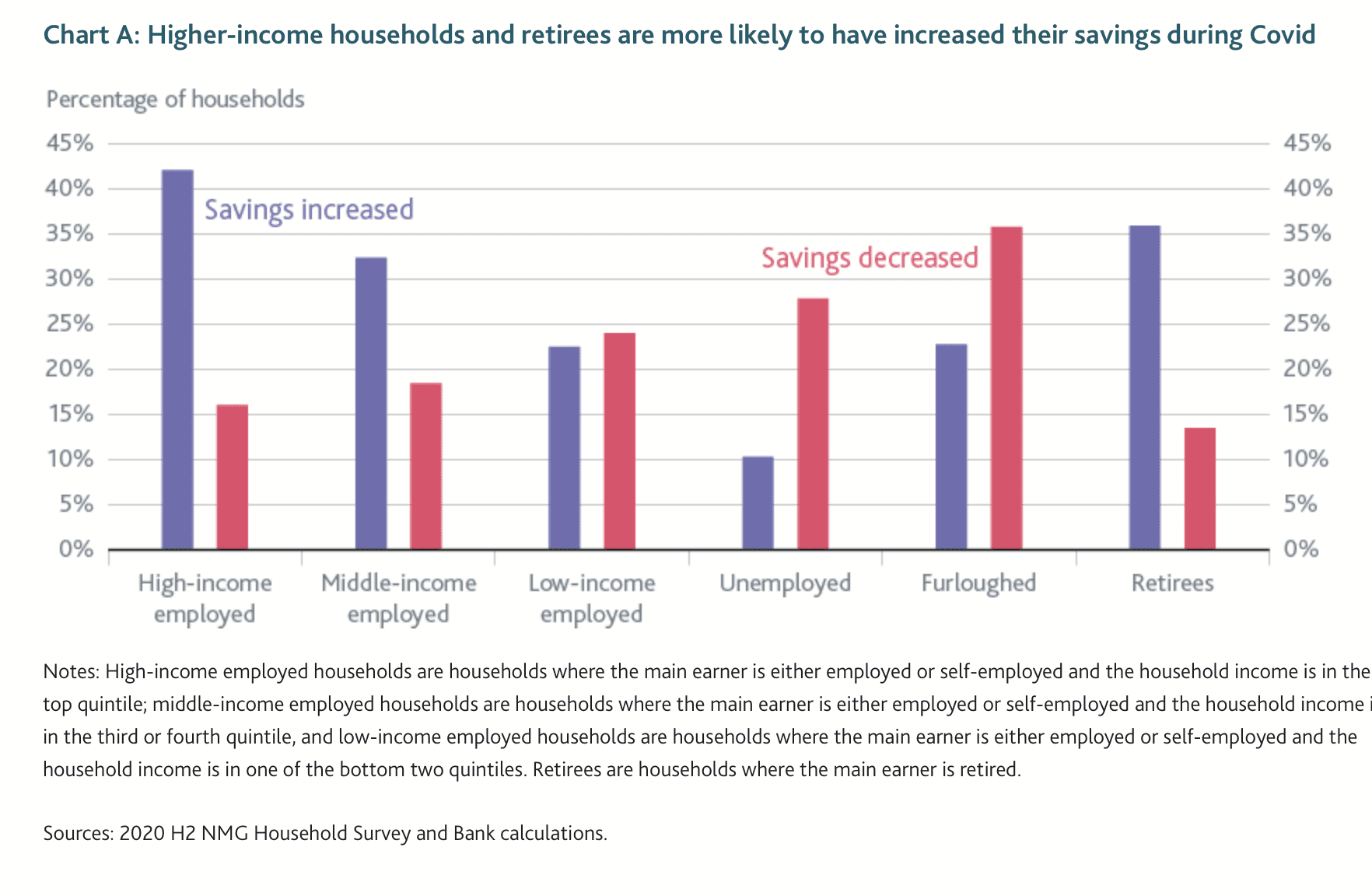People who have more money can give more away
The title may seem like a simple truism, but right now there is a sizeable group of people sitting on a growing nest egg. In this article from Mark Phillips of Bluefrog Fundraising, you’ll find simple ways to adjust your approach to mid-level donors – even in times of crisis.
- Written by
- Mark Phillips
- Added
- April 01, 2021

OK. OK. I know. That’s a truism. You obviously have to have some spare cash if you are going to support a charity, but what makes this a particularly interesting point is the recent report from the Governor of the Bank of England, where he explains that saving deposits have increased in value by over £125 billion during the pandemic.
That means there is a sizeable group of people who are sitting on a growing nest egg.
Let’s put that sum into context. In the average year about £10 billion is donated to charity in the UK. People now have more than 12 times that sitting in savings accounts simply because they have spent less over the last year.
And as we have seen from a number of studies, the pandemic has caused a behavioural shift where many of us have reconsidered what our goals should be. The result is more demand for a better, fairer world – even if it is more expensive. There has been a huge increase in people changing their shopping habits by switching to organic produce. For example, The Soil Association reports that the organic market increased to a value of £2.79bn over the last year. That represents a rise of 12.6 per cent on 2019. And we can add to that an increase in Fairtrade sales of 15 per cent.
But as fundraisers, we need to look at how the combination of more income and an increased desire for a different world order is translating to giving when donors actually have an appeal in their hands.
Let’s start by taking a look at where this additional wealth is concentrating and why. As we know from our personal experience, much of this saving is enforced. People simply can’t spend as much as they used to on social expenditure – eating out, entertainment, going to the pub or even inviting friends over for dinner. The Bank of England has shown that this has impacted on us in different ways:

Many more people who are employed on a low income (that means a household income of under £20,500 a year) along with those who are furloughed or unemployed have struggled to save – many have also had to spend more. For example, they may have been forced to visit more expensive local shops as they have been unable to travel to large superstores. Against this, significant numbers of both high and middle-income employed people have seen increases in savings – as have retirees. It’s a similar position in the USA.
It’s one of the key findings we’ve gained from speaking to donors about the impact of the pandemic on their lives. Many people –particularly older donors – are wealthier. The three following quotes are from different donors, but all highlight the same point:
‘People my age – because I live in a retirement complex, they are saying I don’t know what to do with my money, I’ve saved so much.’
‘Being retired and having enough income with the pension it’s not affected us in that way. Obviously, we’re not seeing family – that’s a bit… And we always go to my son once a year and we couldn’t do that. We’ve been healthy and doing what we’re told. … it comes up on Facebook – ‘during these times we are having a hard time,’ and they do say on the television. I don’t understand if people are paying monthly why they would stop because of the pandemic.’
‘As far as I know my income is not going to be affected, whereas those who have lost their jobs it’s different. I probably would respond more to appeals now.’
So how is this impacting on giving?
I’ve been able to look at a number of different sets of results where I can compare income to Christmas appeals from 2019 and 2020. Every single Christmas appeal in 2020 has done very well.
Broadly, we have seen an increase in response rate in the order of between 20 per cent to 30 per cent (with a few outliers). That means (theoretically) if we saw an 18 per cent to 20 per cent response rate to a Christmas appeal in 2019, we are seeing over 25 per cent in 2020.
However, there is a more pronounced difference in the impact on average gift size. Standard donors might have increased the average size of their gifts by about 20 per cent – from £20 to £25. But average gift sizes from mid-value donors have stayed relatively static at, for example, about £250. And in some cases, they have perhaps even fallen by a few pounds.
Don’t get me wrong. We have seen some huge sums donated by some donors, but broadly, the mid-value segment has seen an increase in response rate – but not in size of average gift –even though many people now have significantly more funds available to support charities. And there are a number of reasons for this.
Most importantly, mid-value donors are much more likely to plan their gifts. They often have a charitable budget where sums will be pre-allocated for specific charities – particularly at Christmas.
Because of this, mid-value donors tend to need a much stronger reason to increase their giving. Uplift messages built around asking for more tend to need plenty of strong evidence to back up why more is required.
And just like many other people who give to charity, mid-value donors are reporting (in our research) that they are adding additional organisations to their portfolios. So rather than increasing gift sizes, it appears extra income is going to different (new) organisations. We’ve also seen plenty of evidence of people giving to support areas of work that they might not have considered as having a very high need prior to coronavirus – arts organisations for example.
There’s more on how donors manage their portfolios here.
So what can we do to increase giving from mid-value donors? This year has been so full-on that it’s understandable that fundraisers have not necessarily given this group more attention, but here are a few approaches that you might want to consider as part of your creative planning for 2021.
Recognise that they plan. Look at your data and see if you can find patterns as to how your donors give. As I’ve mentioned, they often give twice a year – at Christmas and at a time that’s important to them. If you see this pattern appearing, consider feeding back to your donor shortly before their next giving window to update them on what their gift has achieved, and what more there is that they can do. Share your plans and ask them if there is anything that you can do to help with their budgeting and planning. And it doesn’t hurt to remind your mid-value supporters about successes achieved during the pandemic. People will reward this as well as giving to answer need.
Special is normal. This is the old mid-value adage that I have repeated in virtually every mid-value presentation I’ve ever given. Mid-value donors tend to expect special treatment as a normal part of their lives. To fit in with this expectation, it can help if you make your appeal as personal as you can. The use of Post-its and hand annotation works wonders as does a detailed background to the project you are featuring. Think less design and more authenticity. But don’t stop at appeals – also look at how you thank. Again, personalisation is very important. Show the donor that you recognise their generosity, explain how you plan to use their gift, how it fits into the project budget and what they should expect from you next. By treating them as a partner rather than a donor you will bring them closer and give them an opportunity to share in your success.
Remind people that they have been lucky. Many donors are acutely aware that the economic impact of coronavirus has not been spread equally. In conversations, we’ve heard that ‘it could have been me’ time after time. Giving is a way for people to show gratitude for their good fortune and help rebalance their emotions. Don’t be frightened to ask if people are spending less in your copy.
Refine your offer. What are you asking for? One of the most effective ways to encourage a donor to consider what they will give is to change your offer, As Rachael Harris (Bluefrog’s head of creative planning) advises,
‘If you are struggling, consider linking the donor’s gift directly to its outcome, and try shifting away from the services it will pay for.’
This may seem counter intuitive, but it can change your focus and position your offer in a way that provides a richer experience of change. And that may well be something that will drive extra generosity.

















